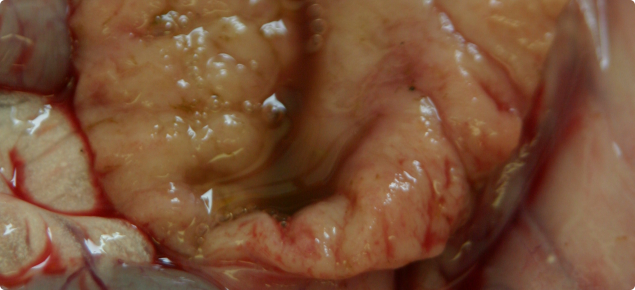Johne’s disease must be reported
Under the Biosecurity and Agriculture Management Act 2007 (BAM Act), the detection of any strain of Johne’s disease (JD) in any species in Western Australia must be reported, in order to support certification for live export markets. As a reportable disease, anyone with a suspicion or detection of JD in livestock must report it to a BAM Act authorised inspector, such as a DPIRD Field Veterinary Officer, as soon as possible.
What is Johne’s disease (JD)?
Johne’s disease (JD) is a chronic, incurable infectious disease that affects sheep, cattle, buffalo, goats, alpaca and deer, and results in wasting and eventually death.
JD is caused by the bacteria Mycobacterium avium subsp. paratuberculosis. The bacteria affect the intestines, preventing absorption of nutrients, and the bacteria are then shed in the faeces of infected animals.
JD is defined as infection with any strain of Mycobacterium avium subsp. paratuberculosis, which includes sheep (S-strain), cattle (C-strain) and bison (B-strain). These strains can affect more than one species, not just the strain they are named for. JD in cattle is commonly referred to as bovine JD (BJD) and in sheep as ovine JD (OJD).
Where Johne’s disease occurs
JD occurs in most countries of the world.
JD in sheep was first diagnosed in Australia in 1980 in New South Wales. Since then, the number of infected flocks has slowly increased.
The disease was first detected in WA in 2000. By 2003 it had been detected on several properties and was shown to have been on those properties for some time. The disease is now endemic in WA and most sheep areas of Australia.
Identifying signs of JD in sheep
The slow and insidious nature of JD means it can spread via sheep movements well before the most observant owner has any indication the disease is present.
Sheep infected by JD may take three to five years to show signs of the infection. The signs of JD in infected animals are often triggered by stress factors such as lambing, mustering, yarding.
Typical signs of JD in sheep include:
- Sheep lose condition/are ill-thrifty despite adequate feed/nutrition and parasite control, and usually die within a 12-week period.
- There is a 'tail' of poor sheep in adult mobs.
- Scouring may be seen but is not always present.
Contact your veterinarian if you see any of the above signs.
There is no treatment for JD.
How JD spreads
JD has a long incubation period. The time between infection and the sheep shedding bacteria in faeces is generally nine months to two years.
JD bacteria may survive in moist, shaded areas for 12 months or more. Survival time is shorter when exposed to sunlight but can vary depending on ground cover and other factors.
Sheep become infected when they consume pasture or water contaminated by these infected faeces. Other susceptible species, including cattle, may also become infected when co-grazing with sheep or grazing affected areas after sheep.
Susceptibility to JD infection decreases with age; animals over two years old are much less likely to become infected. Lambs and weaners are most at risk of picking up infection. Stress and the presence of other diseases increase susceptibility.
The most common means of spread between properties is movement of livestock, either as purchased or agisted animals, or straying stock. Sheep and other JD-susceptible species can carry the bacteria and spread the disease before showing any obvious signs.
Faeces and contaminated run-off/waterways can also spread infection, as may contaminated vehicles, machinery and footwear.
See the webpage Johne’s disease (JD) in sheep: biosecurity and management for details of biosecurity practices to reduce the risk of introducing JD to your property.
Post-mortem testing for JD
Producers should call a private or government veterinarian to investigate if they see sheep in poor body condition that do not respond to drenching and good nutrition. Early detection will help you to manage the disease more effectively and reduce the risk of further spread.
When carrying out a post-mortem of a sheep, if the intestines and lymph nodes show signs similar to JD, the vet will submit samples to the DPIRD laboratory to confirm a diagnosis.
DPIRD subsidised disease investigations and testing are available where JD is suspected. Please contact your private vet or DPIRD Field Veterinary Officer for details.
Abattoir surveillance
Abattoir inspections for JD in sheep can be carried at one of the processors in the Great Southern on request. For more information, contact the WA JD coordinator Dr Courtenay Bombara as below.
Examining the intestines of adult sheep at abattoir provides a practical and cost-effective method of detecting JD in flocks. Trained inspectors inspect lines of adult sheep for visible signs of JD in the intestines and lymph nodes. Where there is suspicion of JD, samples are sent to the DPIRD laboratory for testing to confirm a diagnosis.
JD testing on live animals
Faecal testing
JD is diagnosed in live sheep by finding the bacteria in the faeces. The standard test to detect JD in a flock involves testing a sample of faeces from 350 adult sheep (two years and older) by high-throughput Johne’s (H-T J) PCR tests.
Not all infected animals shed bacteria in their faeces, particularly in the early stages of the disease. For this reason, JD tests that rely on finding the bacteria in the faeces have a limited ability to detect individual infected sheep. Young animals and those in the early stages of infection are particularly difficult to diagnose. Testing individual sheep is impractical and costly.
Blood testing
Blood testing for JD detects when antibodies have been established to an infection with JD. Although the test is cheaper, it is less sensitive and not recommended for herd testing.


